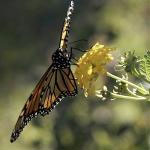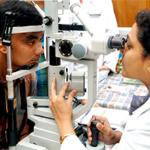
BOB DOUGHTY: This is SCIENCE IN THE NEWS, in VOA Special English. I'm Bob Doughty.
STEVE EMBER: And I'm Steve Ember. This week, we tell about North America's monarch butterfly. We will tell about a British investigation of information stolen from climate researchers. And, we will tell about an honor for the largest eye care provider in the world.
(MUSIC)
Monarch Butterflies
BOB DOUGHTY: Millions of monarch butterflies escape cold weather in North America by flying to the mountains of Mexico every winter. Many people come to see the butterflies in the forests of Mexico's Michoacan State. The beautiful orange and black insects return to the same area each year. They travel up to 4,800 kilometers, from as far away as Canada.
In the spring, the female monarchs leave Mexico and fly as far north as the American state of Kansas. There they leave their eggs on milkweed plants, with the next generation of monarchs appearing a short time later.
But this year, experts say the butterfly population has dropped by as much as 50 percent. Chip Taylor is director of the monarch Watch program at the University of Kansas. He says fewer monarchs are returning this year than any other year he has witnessed.
STEVE EMBER: Severe winter weather, heavy rains and landslides are believed to have destroyed much of the butterfly population. Illegal destruction of the monarch's winter home in Mexico is also blamed for the population drop. Adding to the problem, scientists say, was an already reduced population, resulting from poor conditions last summer.
Professor Taylor is urging people in the southern United States to help the monarchs by planting milkweed. The plant is a favorite place for the butterflies. Many leave their eggs on milkweed at the end of their difficult trip.
BOB DOUGHTY: Researchers continue to make discoveries about how monarch butterflies travel to the same area each year. Without the help of guides or maps, the butterflies use sight, smell, touch and other senses to find their way. To learn how this is done, researchers first observe the normal flight paths of the insects. The researchers then purposely interfere with the monarchs and follow their movement again.
Professor Taylor says his team used this method to discover that butterflies depend on information about the Earth's magnetic fields. He says that, when researchers changed the magnetic field, the butterflies were no longer able to find their way.
STEVE EMBER: Researchers have also found that sunlight is an important tool used by butterflies. By using unnatural light, the insects traveled in the wrong direction.
Steven Reppert also studies butterfly migration. He is a neuroscientist at the University of Massachusetts.
Professor Reppert says scientists thought they understood the control system in the monarchs until they took a closer look at the insects' antenna. He says the antenna can identify odors, as well movement, sounds and changes in barometric pressure. It can also sense light. The antenna sends information to the brain of the butterfly, controlling its behavior.
(MUSIC)
Climate Change E-Mails
BOB DOUGHTY: Earlier this year, we told about an incident that brought attention to disagreements about the cause of rising temperatures in Earth's atmosphere. Private e-mails and documents were stolen from the Climatic Research Unit at the University of East Anglia in Britain. The information was placed on the Internet.
Recently, a British parliamentary committee finished its investigation of the incident. The committee released a mixed report about the leaked or hacked e-mails.
The investigators say they found no evidence that the university's scientists cheated to prove the existence of human-caused climate change. The report said the director of the Climatic Research Unit did not attempt to hide evidence disputing the warming of Earth's atmosphere. But it criticized the University of East Anglia for holding back information from other scientists. The investigators said the secrecy may have violated Britain's public information laws.
STEVE EMBER: Parliament appointed a 14-member committee to investigate the case. The report said information requests by scientists not connected with the Climatic Research Unit, the C.R.U., were continually rejected. Those scientists included researchers who question the idea that human activity is causing temperatures in the atmosphere to rise.
The committee report was the first of three planned to deal with the release of the C.R.U.'s private e-mails on the Internet. C.R.U. director Phil Jones has temporarily left his position until the investigations are completed.
BOB DOUGHTY: The C.R.U. became the object of widespread attention shortly before an international climate conference opened in Denmark last December. In November, more than 1,000 e-mails and about 3,000 documents were taken from the C.R.U. and placed on the Internet.
Other scientists and observers say they found both mistakes and questionable findings. An example was the statement that the Himalayan glaciers would melt by 2035. The prediction was soon disproved.
STEVE EMBER: The United Nations' Intergovernmental Panel on Climate Change had included that prediction in a report three years ago. Recognition of such mistakes forced I.P.C.C. chairman Rajendra Pachauri to resign. That same year Mr. Pachauri won a Nobel Prize for his work on climate change. He shared the award with America's former vice president, Al Gore. Mr. Gore has been a strong activist for limiting Earth's temperatures.
Professor Jones had used the words "trick" and "hide the decline" in relation to a graph showing temperature decreases. The image has appeared in several publications. But the Parliamentary committee said the professor was not guilty of wrongdoing in the incident.
BOB DOUGHTY: The e-mails included personal insults to dissenters of C.R.U. studies. Professor Jones admitted to the committee that some of the messages were what he called awful.
Two other reports will study the C.R.U. itself and explore possible violation of Britain's freedom of information laws. At the same time, the Norfolk Police Constabulary is investigating the possibility of criminal activity. Detective Superintendent Julian Gregory will say only that the case is complex and will take more time to finish.
(MUSIC)
Aravind Eye Care System
STEVE EMBER: An eye care organization in India was honored this month for its efforts. Aravind Eye Care System received the Conrad N. Hilton Humanitarian Prize. The award was presented in California, during a conference of the Global Philanthropy Forum.
Conrad Hilton established the humanitarian prize in 1996. Each year the award is given to a charitable or non-governmental organization working to end human suffering. The prize includes 1,500,000 dollars.

BOB DOUGHTY: Aravind Eye Care System was recognized for its work with millions of people in India.
Govindappa Venkataswamy, a retired eye surgeon, established the organization in 1976. He wanted to make high quality eye care available to all, especially India's poor. He wanted to prevent needless cases of blindness.
Eight out of ten people with vision problems live in developing countries. The World Health Organization says 85 percent of all vision problems could be prevented or cured. That includes 75 percent of all blindness.
An estimated 45 million people are blind, and India is home to ten million of them.
STEVE EMBER: Doctor Venkataswamy established the first Aravind Eye Hospital in Tamil Nadu state with only 11 beds. Today, Aravind Eye Care System is the largest eye care provider in the world. It operates five hospitals and more than 30 eye care centers across India.
About 70 percent of the patients receive free care. The money comes from the 30 percent of patients who can pay for their services.
In 1992, Aravind established what was described as Asia's first training center for the prevention of blindness. Also, the Aravind Medical Research Foundation investigates the causes and treatment of eye disease.
(MUSIC)
BOB DOUGHTY: This SCIENCE IN THE NEWS was written by June Simms, Jerilyn Watson and Brianna Blake, who also was our producer. I'm Bob Doughty.
STEVE EMBER: And I'm Steve Ember. Listen again next week for more news about science, in Special English, on the Voice of America.
milkweed: 乳草
India's Aravind Eye Care System gets Hilton Prize
(来源:VOA 编辑:陈丹妮)
